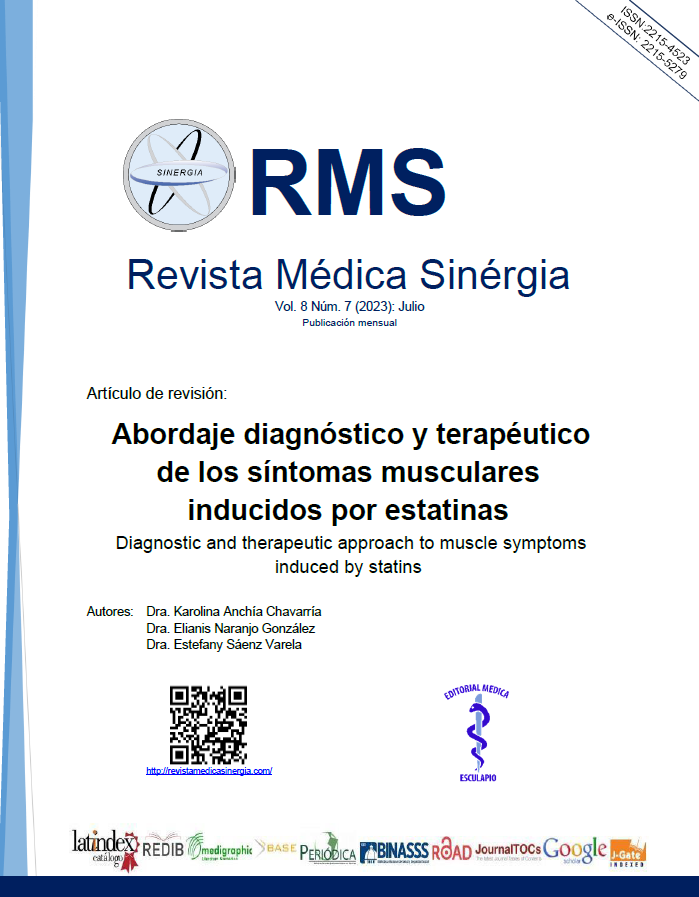Abstract
Statins are the most frequently used pharmacological group of lipid-lowering agents worldwide. A significant reduction in cardiovascular risk in patients with atherosclerosis has been linked to statin use in primary and secondary prevention.
However, over time, multiple adverse effects related to its use have been reported, estimated to range from 1.5% to 20% of cases, depending on the literature consulted. A large group compassing different spectrums of adverse effects is called muscular symptoms associated with statins. These have been frequently reported and constitute a risk for the abandonment of pharmacological therapy. In most cases, these effects are dose-dependent and can encompass different clinical presentations, including myalgias, myositis, creatine kinase (CK) elevation, myopathy, myositis, and myonecrosis. Due to this problem, multiple investigations have been carried out, and many theories have been proposed to identify the mechanisms involved in some patients after using statins. However, so far, these theories have yet to be demonstrated.
What is clear is that certain risk factors increase the probability that patients develop these symptoms, such as concomitant use with fibrates, macrolides, or the type of statin used. There are no clear guidelines for managing statin-induced myopathies; however, it is essential to recognize the symptoms and determine if there is an association between the symptoms and the use of these drugs to eventually make clinical decisions that may impact the patients' lives who use them.
Keywords
References
Ratchford E, Martin S. Statins. Vascular Medicine [Internet]. 2017 [citado el 05 marzo 2023];22(5):442-445. Disponible en:
https://pubmed.ncbi.nlm.nih.gov/28803537/
Insani W, Whittlesea C, Alwafi H, Man K, Chapman S, Wei L. Prevalence of adverse drug reactions in the primary care setting: A systematic review and meta-analysis. PLoS One [Internet]. 2021 [citado el 15 marzo 2023];16(5):e0252161. Disponible en: https://pubmed.ncbi.nlm.nih.gov/34038474/
Peter P, Toth M. That Myalgia of Yours Is Not from Statin Intolerance. JACC [Internet]. 2021 [citado el 05 marzo 2023];78(12):1223-1226. Disponible en: https://pubmed.ncbi.nlm.nih.gov/34531022/
Masson W. Uso adecuado de las estatinas de alta intensidad. Rev.Urug.Cardiol [Internet]. Diciembre, 2019 [citado el 12 enero 2023];34(3):305-332. Disponible en:
http://www.scielo.edu.uy/scielo.php?script=sci_arttext&pid=S1688-04202019000300305&lng=es
Pinal-Fernandez I, Casal-Dominguez M, Mammen AL. Statins: pros and cons. Med Clin. 2018 [citado el 12 enero 2023];150(10):398-402. Disponible en: https://pubmed.ncbi.nlm.nih.gov/29292104/
Lempp P. An Evidence-Based Guideline for Treating Dyslipidemia in Statin-Intolerant Patients. Journal for Nurse Practitioners [Internet]. 2021 [citado el 05 marzo 2023];17(8):910-915. Disponible en: https://www.sciencedirect.com/science/article/pii/S1555415521002786#:~:text=Current%20evidence%20shows%202%20clear,has%20a%20true%20statin%20intolerance
Dicken W, Mehta A, Karagiannis A, Jain V, Vavuranakis M, Sperling L, et al. Statin associated muscle symptoms: An update and review. Progress in Cardiovascular Diseases [Internet]. 2022 [citado el 05 marzo 2023];75:40-48. Disponible en: https://www.sciencedirect.com/science/article/abs/pii/S0033062022001220
Pergolizzi J, Coluzzi F, Colucci R, Olsson H, LeQuang J, AL- Saadi, et al. Statins and muscle pain. Expert Review of Clinical Pharmacology [Internet]. 2020 [citado el 7 marzo 2023];13(5):299-310. Disponible en: https://www.tandfonline.com/doi/full/10.1080/17512433.2020.1734451
Vinci P, Panizon E, Tosoni LM, Cerrato C, Pellicori F, Mearelli F, et al. Statin-Associated Myopathy: Emphasis on Mechanisms and Targeted Therapy. International journal of molecular sciences [Internet]. 28 octubre 2021 [citado el 05 marzo 2023];22(21). Disponible en: https://pubmed.ncbi.nlm.nih.gov/34769118/
Attardo S, Musumeci O, Velardo D, Toscano A. Statins Neuromuscular Adverse Effects. International journal of molecular sciences [Internet]. 28 enero 2022 [citado el 05 marzo 2023];23(15). Disponible en: https://www.mdpi.com/1422-0067/23/15/8364
Nguyen KA, Li L, Lu D, Yazdanparast A, Wang L, Kreutz RP, et al. A comprehensive review and meta-analysis of risk factors for statin-induced myopathy. European journal of clinical pharmacology [Internet]. Septiembre 2018 [citado el 05 marzo 2023];74(9):1099–109. Disponible en: https://pubmed.ncbi.nlm.nih.gov/29785580/
Camerino GM, Tarantino N, Canfora I, De Bellis M, Musumeci O, Pierno S. Statin-Induced Myopathy: Translational Studies from Preclinical to Clinical Evidence. International journal of molecular sciences [Internet]. 19 febrero 2021 [citado el 05 marzo 2023];22(4). Disponible en: https://pubmed.ncbi.nlm.nih.gov/33669797/
Rallidis L. A practical algorithm for the management of patients with statin-associated muscle symptoms. Hellenic Journal of Cardiology. [Internet]. 2020 [citado el 05 marzo 2023];61(2). Disponible en: https://www.sciencedirect.com/science/article/pii/S1109966619302842
Adhyaru B, Jacobson T. Safety and efficacy of statin therapy. Nature Reviews Cardiology [Internet]. 2022 [citado el 05 marzo 2023];15. Disponible en: https://doi.org/10.1038/s41569-018-0098-5
Muñoz-Blanco A, Gómez-Huelga R, Gómez-Cerezo J. Sintomatología muscular asociada a estatinas: ¿mito o realidad?. Revista Clínica Española [Internet]. 2022 [citado el 07 de marzo, 2023];22(10):602-611. Disponible en: https://www.revclinesp.es/es-sintomatologia-muscular-asociada-estatinas-mito-articulo-S0014256522000698

This work is licensed under a Creative Commons Attribution-NonCommercial 4.0 International License.
Copyright (c) 2023 Array


